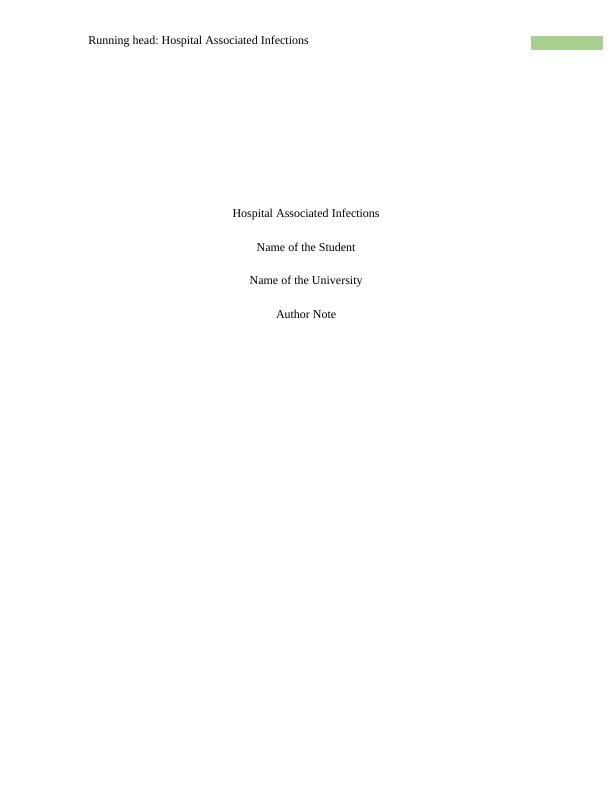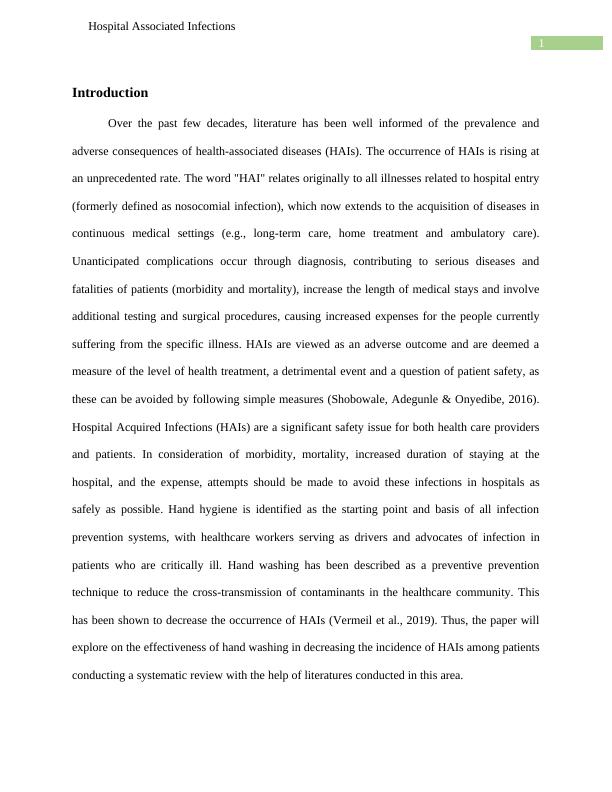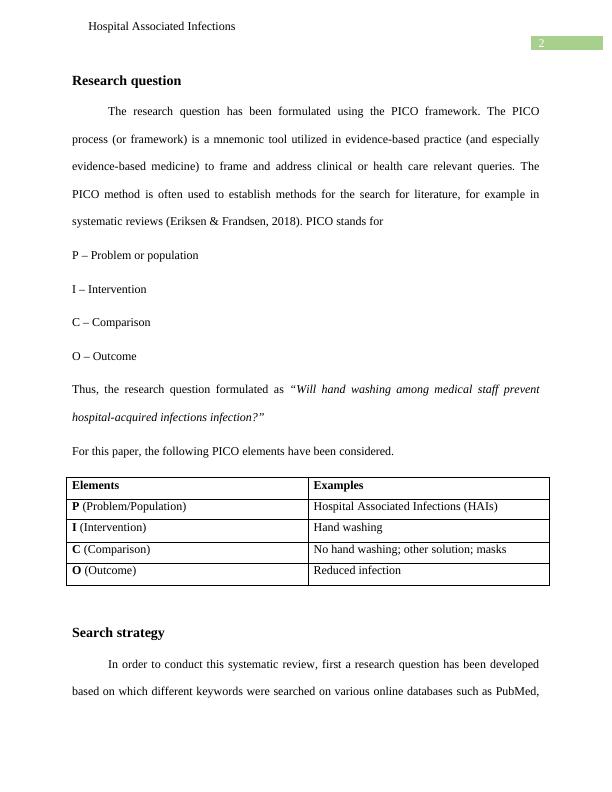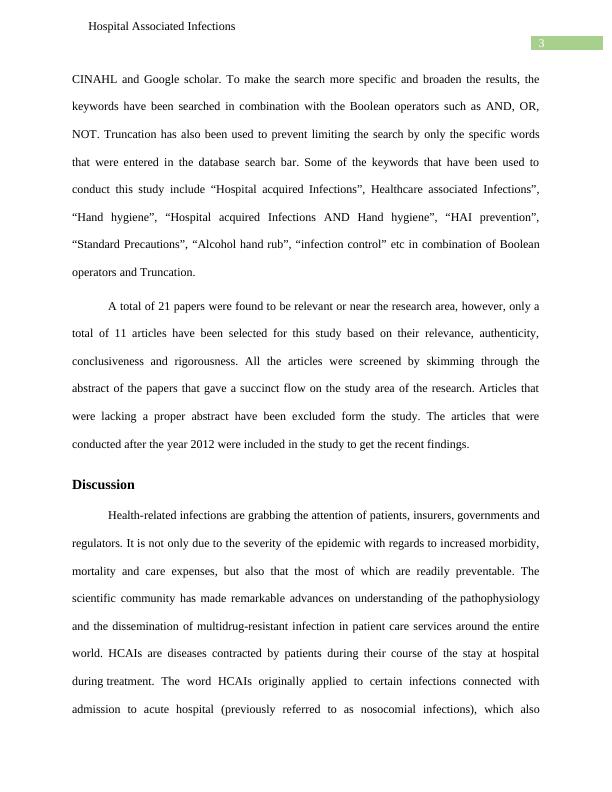Hospital Associated Infections Research Paper 2022
Added on 2022-09-18
12 Pages3309 Words26 Views
Running head: Hospital Associated Infections
Hospital Associated Infections
Name of the Student
Name of the University
Author Note
Hospital Associated Infections
Name of the Student
Name of the University
Author Note

1
Hospital Associated Infections
Introduction
Over the past few decades, literature has been well informed of the prevalence and
adverse consequences of health-associated diseases (HAIs). The occurrence of HAIs is rising at
an unprecedented rate. The word "HAI" relates originally to all illnesses related to hospital entry
(formerly defined as nosocomial infection), which now extends to the acquisition of diseases in
continuous medical settings (e.g., long-term care, home treatment and ambulatory care).
Unanticipated complications occur through diagnosis, contributing to serious diseases and
fatalities of patients (morbidity and mortality), increase the length of medical stays and involve
additional testing and surgical procedures, causing increased expenses for the people currently
suffering from the specific illness. HAIs are viewed as an adverse outcome and are deemed a
measure of the level of health treatment, a detrimental event and a question of patient safety, as
these can be avoided by following simple measures (Shobowale, Adegunle & Onyedibe, 2016).
Hospital Acquired Infections (HAIs) are a significant safety issue for both health care providers
and patients. In consideration of morbidity, mortality, increased duration of staying at the
hospital, and the expense, attempts should be made to avoid these infections in hospitals as
safely as possible. Hand hygiene is identified as the starting point and basis of all infection
prevention systems, with healthcare workers serving as drivers and advocates of infection in
patients who are critically ill. Hand washing has been described as a preventive prevention
technique to reduce the cross-transmission of contaminants in the healthcare community. This
has been shown to decrease the occurrence of HAIs (Vermeil et al., 2019). Thus, the paper will
explore on the effectiveness of hand washing in decreasing the incidence of HAIs among patients
conducting a systematic review with the help of literatures conducted in this area.
Hospital Associated Infections
Introduction
Over the past few decades, literature has been well informed of the prevalence and
adverse consequences of health-associated diseases (HAIs). The occurrence of HAIs is rising at
an unprecedented rate. The word "HAI" relates originally to all illnesses related to hospital entry
(formerly defined as nosocomial infection), which now extends to the acquisition of diseases in
continuous medical settings (e.g., long-term care, home treatment and ambulatory care).
Unanticipated complications occur through diagnosis, contributing to serious diseases and
fatalities of patients (morbidity and mortality), increase the length of medical stays and involve
additional testing and surgical procedures, causing increased expenses for the people currently
suffering from the specific illness. HAIs are viewed as an adverse outcome and are deemed a
measure of the level of health treatment, a detrimental event and a question of patient safety, as
these can be avoided by following simple measures (Shobowale, Adegunle & Onyedibe, 2016).
Hospital Acquired Infections (HAIs) are a significant safety issue for both health care providers
and patients. In consideration of morbidity, mortality, increased duration of staying at the
hospital, and the expense, attempts should be made to avoid these infections in hospitals as
safely as possible. Hand hygiene is identified as the starting point and basis of all infection
prevention systems, with healthcare workers serving as drivers and advocates of infection in
patients who are critically ill. Hand washing has been described as a preventive prevention
technique to reduce the cross-transmission of contaminants in the healthcare community. This
has been shown to decrease the occurrence of HAIs (Vermeil et al., 2019). Thus, the paper will
explore on the effectiveness of hand washing in decreasing the incidence of HAIs among patients
conducting a systematic review with the help of literatures conducted in this area.

2
Hospital Associated Infections
Research question
The research question has been formulated using the PICO framework. The PICO
process (or framework) is a mnemonic tool utilized in evidence-based practice (and especially
evidence-based medicine) to frame and address clinical or health care relevant queries. The
PICO method is often used to establish methods for the search for literature, for example in
systematic reviews (Eriksen & Frandsen, 2018). PICO stands for
P – Problem or population
I – Intervention
C – Comparison
O – Outcome
Thus, the research question formulated as “Will hand washing among medical staff prevent
hospital-acquired infections infection?”
For this paper, the following PICO elements have been considered.
Elements Examples
P (Problem/Population) Hospital Associated Infections (HAIs)
I (Intervention) Hand washing
C (Comparison) No hand washing; other solution; masks
O (Outcome) Reduced infection
Search strategy
In order to conduct this systematic review, first a research question has been developed
based on which different keywords were searched on various online databases such as PubMed,
Hospital Associated Infections
Research question
The research question has been formulated using the PICO framework. The PICO
process (or framework) is a mnemonic tool utilized in evidence-based practice (and especially
evidence-based medicine) to frame and address clinical or health care relevant queries. The
PICO method is often used to establish methods for the search for literature, for example in
systematic reviews (Eriksen & Frandsen, 2018). PICO stands for
P – Problem or population
I – Intervention
C – Comparison
O – Outcome
Thus, the research question formulated as “Will hand washing among medical staff prevent
hospital-acquired infections infection?”
For this paper, the following PICO elements have been considered.
Elements Examples
P (Problem/Population) Hospital Associated Infections (HAIs)
I (Intervention) Hand washing
C (Comparison) No hand washing; other solution; masks
O (Outcome) Reduced infection
Search strategy
In order to conduct this systematic review, first a research question has been developed
based on which different keywords were searched on various online databases such as PubMed,

3
Hospital Associated Infections
CINAHL and Google scholar. To make the search more specific and broaden the results, the
keywords have been searched in combination with the Boolean operators such as AND, OR,
NOT. Truncation has also been used to prevent limiting the search by only the specific words
that were entered in the database search bar. Some of the keywords that have been used to
conduct this study include “Hospital acquired Infections”, Healthcare associated Infections”,
“Hand hygiene”, “Hospital acquired Infections AND Hand hygiene”, “HAI prevention”,
“Standard Precautions”, “Alcohol hand rub”, “infection control” etc in combination of Boolean
operators and Truncation.
A total of 21 papers were found to be relevant or near the research area, however, only a
total of 11 articles have been selected for this study based on their relevance, authenticity,
conclusiveness and rigorousness. All the articles were screened by skimming through the
abstract of the papers that gave a succinct flow on the study area of the research. Articles that
were lacking a proper abstract have been excluded form the study. The articles that were
conducted after the year 2012 were included in the study to get the recent findings.
Discussion
Health-related infections are grabbing the attention of patients, insurers, governments and
regulators. It is not only due to the severity of the epidemic with regards to increased morbidity,
mortality and care expenses, but also that the most of which are readily preventable. The
scientific community has made remarkable advances on understanding of the pathophysiology
and the dissemination of multidrug-resistant infection in patient care services around the entire
world. HCAIs are diseases contracted by patients during their course of the stay at hospital
during treatment. The word HCAIs originally applied to certain infections connected with
admission to acute hospital (previously referred to as nosocomial infections), which also
Hospital Associated Infections
CINAHL and Google scholar. To make the search more specific and broaden the results, the
keywords have been searched in combination with the Boolean operators such as AND, OR,
NOT. Truncation has also been used to prevent limiting the search by only the specific words
that were entered in the database search bar. Some of the keywords that have been used to
conduct this study include “Hospital acquired Infections”, Healthcare associated Infections”,
“Hand hygiene”, “Hospital acquired Infections AND Hand hygiene”, “HAI prevention”,
“Standard Precautions”, “Alcohol hand rub”, “infection control” etc in combination of Boolean
operators and Truncation.
A total of 21 papers were found to be relevant or near the research area, however, only a
total of 11 articles have been selected for this study based on their relevance, authenticity,
conclusiveness and rigorousness. All the articles were screened by skimming through the
abstract of the papers that gave a succinct flow on the study area of the research. Articles that
were lacking a proper abstract have been excluded form the study. The articles that were
conducted after the year 2012 were included in the study to get the recent findings.
Discussion
Health-related infections are grabbing the attention of patients, insurers, governments and
regulators. It is not only due to the severity of the epidemic with regards to increased morbidity,
mortality and care expenses, but also that the most of which are readily preventable. The
scientific community has made remarkable advances on understanding of the pathophysiology
and the dissemination of multidrug-resistant infection in patient care services around the entire
world. HCAIs are diseases contracted by patients during their course of the stay at hospital
during treatment. The word HCAIs originally applied to certain infections connected with
admission to acute hospital (previously referred to as nosocomial infections), which also

End of preview
Want to access all the pages? Upload your documents or become a member.
Related Documents
Assignment on Evidence Based Practice Projectlg...
|17
|3425
|14
Hand Hygiene Literature Review 2022lg...
|11
|2914
|17
Hand Hygiene: Importance, Strategies, and Recommendationslg...
|23
|6060
|240
Hand Washing under Acute Care Settings | Reportlg...
|13
|2986
|17
importance Of Hand Hygiene And Practicelg...
|1
|816
|41
Hand Hygiene in Hospital Care Setting | Reportlg...
|13
|3135
|21
